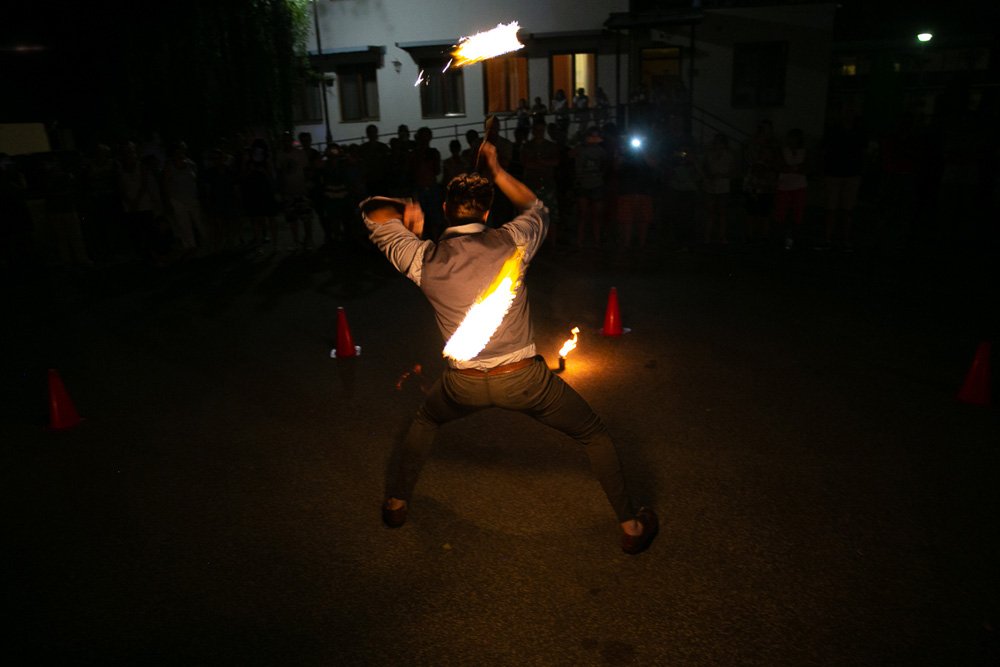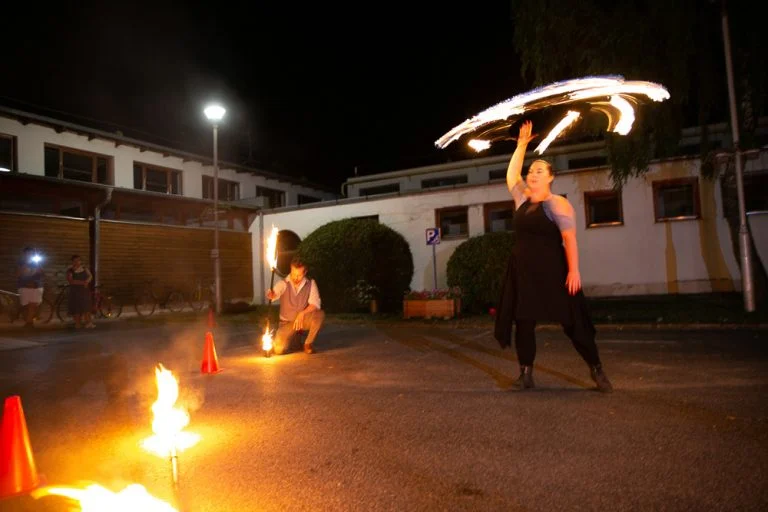tal and Physical Conditioning for Fire Dancers
Fire dancing captivates audiences with its mesmerizing combination of fluid movement, pyrotechnic artistry, and calculated peril. But behind every spectacular performance lies a rigorous regimen of mental and physical conditioning that ensures both safety and visual impact. For event organizers and municipalities booking professional fire dancers, understanding the training that goes into each act is essential to appreciating the craft—and investing wisely.
The Demands of Fire Dancing
Fire dancing is far more than performance art; it’s an extreme physical discipline fused with split-second coordination and deep psychological focus. Whether a dancer performs poi, fire fans, or fire staff, the integration of fitness and flexibility training directly influences their stamina, control, and safety.
“Fire tools move fast, burn hot, and punish mistakes. Training isn’t optional—it’s the foundation of every show.” — Malia N., professional fire performer at Hestia Fire Dance
Why Fire Dancers Need Specialized Conditioning
Unlike stage performers or athletes in other disciplines, fire dancers must train with both performance precision and risk management in mind. According to a 2022 report by the International Flow Arts Coalition, over 60% of fire performance-related injuries occur due to lack of conditioning or beginner-level errors. This makes structured training more than just a best practice—it’s a critical safety requirement.
Physical Conditioning: Building a Fire-Ready Body
1. Cardiovascular Endurance
Fire dancing sequences can last from 3 to 10 minutes of continuous movement under hot stage lights and near open flames. Dancers follow cardio-intensive routines such as:
- High-Intensity Interval Training (HIIT)
- Jump rope circuits
- Bodyweight plyometrics
This builds stamina to maintain energy without compromising technique.
2. Strength Training for Injury Prevention
Controlled power is essential when spinning flaming props. Dancers frequently train for core stability and upper-body strength using:
- Resistance workouts (bands, kettlebells)
- Bodyweight movements (e.g., push-ups, planks)
- Grip strength training for tool handling
The goal is reducing fatigue-related accidents during complex choreography.
3. Flexibility and Mobility Drills
Mastering aerial spins or floor rolls requires flexible joints and limber muscles. Name-brand performers frequently dedicate 15–30 minutes daily to:
- Dynamic stretching before practice
- Yoga or Pilates for balance and alignment
- Foam rolling to release trigger points
This opens movement pathways and prevents strains during rapid performance routines.
Mental Conditioning: The Psychology of Fire Performance
Keeping cool under literal pressure isn’t just poetic—it’s essential. Fire dancing demands a calm, alert mind able to respond instantly to environmental shifts or equipment misfires. That’s why established dancers turn to mental fitness practices to enhance focus and composure.
1. Visualization Techniques
Many performers use mental rehearsal prior to shows, imagining ideal execution and troubleshooting mid-show mistakes before they happen. This increases reaction speed and builds confidence.
2. Breathwork and Meditation
Fire dancing pushes heart rates and adrenaline spikes. To counteract stress, dancers develop breath control through:
- Box breathing to calm nerves
- Brief meditation to center awareness
- Pre-performance body scans
3. Risk Mindfulness and Safety Protocols
Conditioned minds recognize and respond to danger signs instantly. Leading groups like Hestia Fire Dance conduct mental drills simulating equipment failure or fuel spills—training muscle memory and mental agility equally.
The Benefits of Full-Spectrum Conditioning
Event organizers often focus on the “wow” factor of fire dancing, but it’s the behind-the-scenes preparation that ensures:
- Flawless, repeatable performances suitable for televised or large-scale audiences.
- Reduced liability through elevated safety awareness and preparedness.
- Higher crowd engagement thanks to the dancer’s full physical and expressive command.
When booking fire dancers for festivals, corporate events, or public celebrations, ask about their fitness and flexibility training protocols. It’s a key benchmark for professionalism.
Real-World Application: Hestia Fire Dance
At Hestia Fire Dance, every troupe member undergoes quarterly conditioning reviews including:
- Fitness assessments and progress tracking
- Choreography integrated with strength programming
- Mental resilience workshops led by performance psychologists
This ensures each act maintains the highest artistic and safety standards, offering event planners peace of mind—and unforgettable visuals.
Conclusion
Fire dancing may look effortless and wild, but it is rooted in a deeply disciplined culture of mental and physical conditioning. From customized endurance drills to psychological composure training, performance success isn’t about raw talent alone—it’s trained, tested, and constantly refined.
For event professionals seeking world-class impact paired with meticulous risk management, choosing highly trained fire dancers makes all the difference.
Ready to elevate your event with unforgettable fire artistry? Contact Hestia Fire Dance to book a show that blends spectacle with professionalism.
Key Takeaways
- Professional fire dancers rely on consistent fitness, flexibility, and mental discipline to perform safely and impressively.
- Physical training includes strength workouts, cardio endurance, and injury prevention strategies.
- Mental conditioning focuses on mindfulness, breath control, and scenario preparation to enhance performance reliability.
- Proper training reduces risk and maximizes show quality, critical for high-stakes events.
- Organizations like Hestia Fire Dance integrate these methods to deliver turnkey entertainment experiences.




